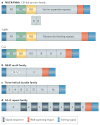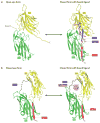Adhesion, invasion and evasion: the many functions of the surface proteins of Staphylococcus aureus
- PMID: 24336184
- PMCID: PMC5708296
- DOI: 10.1038/nrmicro3161
Adhesion, invasion and evasion: the many functions of the surface proteins of Staphylococcus aureus
Abstract
Staphylococcus aureus is an important opportunistic pathogen and persistently colonizes about 20% of the human population. Its surface is 'decorated' with proteins that are covalently anchored to the cell wall peptidoglycan. Structural and functional analysis has identified four distinct classes of surface proteins, of which microbial surface component recognizing adhesive matrix molecules (MSCRAMMs) are the largest class. These surface proteins have numerous functions, including adhesion to and invasion of host cells and tissues, evasion of immune responses and biofilm formation. Thus, cell wall-anchored proteins are essential virulence factors for the survival of S. aureus in the commensal state and during invasive infections, and targeting them with vaccines could combat S. aureus infections.
Conflict of interest statement
The authors declare no competing interests.
Figures




References
-
- Otto M. Basis of virulence in community-associated methicillin-resistant Staphylococcus aureus. Annu Rev Microbiol. 2010;64:143–162. - PubMed
Publication types
MeSH terms
Substances
Grants and funding
LinkOut - more resources
Full Text Sources
Other Literature Sources
Molecular Biology Databases

